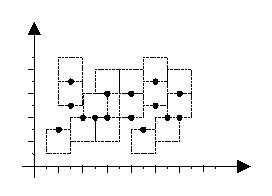POJ 2296 Map Labeler(二分+2SAT可行性判断)
Map Labeler
| Time Limit: 1000MS | Memory Limit: 65536K | |
| Total Submissions: 1023 | Accepted: 337 |
Description
Map generation is a difficult task in cartography. A vital part of such task is automatic labeling of the cities in a map; where for each city there is text label to be attached to its location, so that no two labels overlap. In this problem, we are concerned with a simple case of automatic map labeling.
Assume that each city is a point on the plane, and its label is a text bounded in a square with edges parallel to x and y axis. The label of each city should be located such that the city point appears exactly in the middle of the top or bottom edges of the label. In a good labeling, the square labels are all of the same size, and no two labels overlap, although they may share one edge. Figure 1 depicts an example of a good labeling (the texts of the labels are not shown.)
Given the coordinates of all city points on the map as integer values, you are to find the maximum label size (an integer value) such that a good labeling exists for the map.

Assume that each city is a point on the plane, and its label is a text bounded in a square with edges parallel to x and y axis. The label of each city should be located such that the city point appears exactly in the middle of the top or bottom edges of the label. In a good labeling, the square labels are all of the same size, and no two labels overlap, although they may share one edge. Figure 1 depicts an example of a good labeling (the texts of the labels are not shown.)
Given the coordinates of all city points on the map as integer values, you are to find the maximum label size (an integer value) such that a good labeling exists for the map.

Input
The first line contains a single integer t (1 <= t <= 10), the number of test cases. Each test case starts with a line containing an integer m (3 ≤ m ≤ 100), the number of cities followed by m lines of data each containing a pair of integers; the first integer (X) is the x and the second one (Y) is the y coordinates of one city on the map (-10000 ≤X, Y≤ 10000). Note that no two cities have the same (x, y) coordinates.
Output
The output will be one line per each test case containing the maximum possible label size (an integer value) for a good labeling.
Sample Input
1 6 1 1 2 3 3 2 4 4 10 4 2 5
Sample Output
2
Source
题型:二分+可行性判断。
二分+2-SAT可行性判断
题意:给你n个点,要你在这n个点上放一个正方形,点
只能在正方形的上边或下边的中点上,所有正方形大小一样,
不能重叠,求最大的正方形。。。
如果abs(s[i].x-s[j].x)>=r则可以随便放
如果 abs[s[i].x-s[j].y)<r;
如果abs(s[i].y-s[j].y)<r,如果s[i].y==s[i].y则要求一个放上面一个放下面。
否则只能是上面的点放上面,下面的点放下面。
如果r<=abs(s[i].y-s[j].y)<2*r,则除了上面的点放下方、下面的点放上方的情况都是可以的。
/* POJ 2296 二分+2-SAT可行性判断 题意:给你n个点,要你在这n个点上放一个正方形,点 只能在正方形的上边或下边的中点上,所有正方形大小一样, 不能重叠,求最大的正方形。。。 如果abs(s[i].x-s[j].x)>=r则可以随便放 如果 abs[s[i].x-s[j].y)<r; 如果abs(s[i].y-s[j].y)<r,如果s[i].y==s[i].y则要求一个放上面一个放下面。 否则只能是上面的点放上面,下面的点放下面。 如果r<=abs(s[i].y-s[j].y)<2*r,则除了上面的点放下方、下面的点放上方的情况都是可以的。 C++ 422ms 467K G++ 32ms */ #include<stdio.h> #include<iostream> #include<algorithm> #include<string.h> #include<vector> #include<queue> #include<math.h> using namespace std; const int MAXN=220; bool visit[MAXN]; queue<int>q1,q2; //vector建图方法很妙 vector<vector<int> >adj; //原图 //中间一定要加空格把两个'>'隔开 vector<vector<int> >radj;//逆图 vector<vector<int> >dag;//缩点后的逆向DAG图 int n,cnt; int id[MAXN],order[MAXN],ind[MAXN];//强连通分量,访问顺序,入度 void dfs(int u) { visit[u]=true; int i,len=adj[u].size(); for(i=0;i<len;i++) if(!visit[adj[u][i]]) dfs(adj[u][i]); order[cnt++]=u; } void rdfs(int u) { visit[u]=true; id[u]=cnt; int i,len=radj[u].size(); for(i=0;i<len;i++) if(!visit[radj[u][i]]) rdfs(radj[u][i]); } void korasaju() { int i; memset(visit,false,sizeof(visit)); for(cnt=0,i=0;i<2*n;i++) if(!visit[i]) dfs(i); memset(id,0,sizeof(id)); memset(visit,false,sizeof(visit)); for(cnt=0,i=2*n-1;i>=0;i--) if(!visit[order[i]]) { cnt++;//这个一定要放前面来 rdfs(order[i]); } } bool solvable() { for(int i=0;i<n;i++) if(id[2*i]==id[2*i+1]) return false; return true; } struct Point { int x,y; }s[MAXN]; int main() { int T; int left,right,mid; int ans; scanf("%d",&T); while(T--) { scanf("%d",&n); for(int i=0;i<n;i++) scanf("%d%d",&s[i].x,&s[i].y); left=0; right=80000; while(right-left>=0) { mid=(left+right)>>1; adj.assign(2*n,vector<int>()); radj.assign(2*n,vector<int>()); //2*i表示放上面的,2*i+1表示放下面 for(int i=0;i<n;i++) for(int j=i+1;j<n;j++) { if(abs(s[i].x-s[j].x)>=mid)continue;//没有限制 if(abs(s[i].y-s[j].y)<mid) { if(s[i].y==s[j].y)//一个上一个下 { adj[2*i].push_back(2*j+1); adj[2*j].push_back(2*i+1); adj[2*i+1].push_back(2*j); adj[2*j+1].push_back(2*i); radj[2*i].push_back(2*j+1); radj[2*j].push_back(2*i+1); radj[2*i+1].push_back(2*j); radj[2*j+1].push_back(2*i); } else if(s[i].y>s[j].y)//i放上面,j放下面 { adj[2*i+1].push_back(2*i); adj[2*j].push_back(2*j+1); radj[2*i].push_back(2*i+1); radj[2*j+1].push_back(2*j); } else { adj[2*i].push_back(2*i+1); adj[2*j+1].push_back(2*j); radj[2*i+1].push_back(2*i); radj[2*j].push_back(2*j+1); } } else if(abs(s[i].y-s[j].y)<2*mid)//上面的放下面和下面的放上面是不允许的 { if(s[i].y>s[j].y) { adj[2*i+1].push_back(2*j+1); adj[2*j].push_back(2*i); radj[2*j+1].push_back(2*i+1); radj[2*i].push_back(2*j); } else { adj[2*j+1].push_back(2*i+1); adj[2*i].push_back(2*j); radj[2*i+1].push_back(2*j+1); radj[2*j].push_back(2*i); } } } korasaju(); if(solvable()){ans=mid;left=mid+1;} else right=mid-1; } printf("%d\n",ans); } return 0; }
人一我百!人十我万!永不放弃~~~怀着自信的心,去追逐梦想




